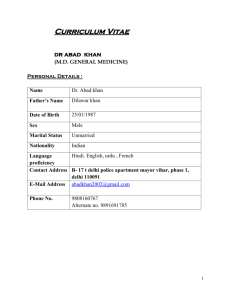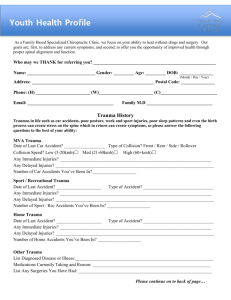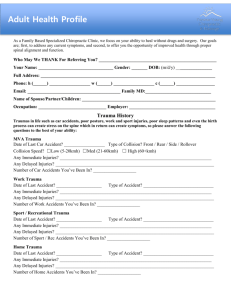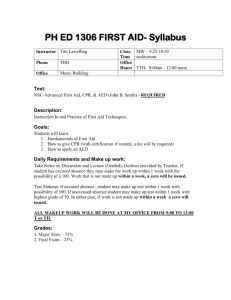385-1969-1-SM - Indian Association of Preventive and Social
advertisement
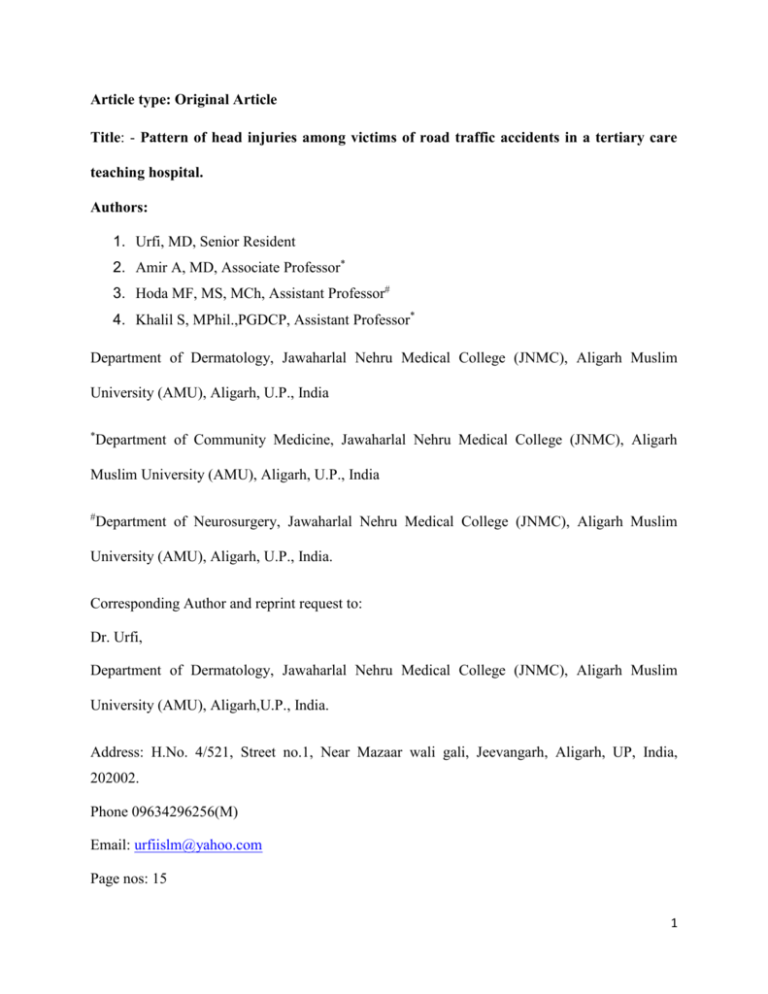
Article type: Original Article Title: - Pattern of head injuries among victims of road traffic accidents in a tertiary care teaching hospital. Authors: 1. Urfi, MD, Senior Resident 2. Amir A, MD, Associate Professor* 3. Hoda MF, MS, MCh, Assistant Professor# 4. Khalil S, MPhil.,PGDCP, Assistant Professor* Department of Dermatology, Jawaharlal Nehru Medical College (JNMC), Aligarh Muslim University (AMU), Aligarh, U.P., India * Department of Community Medicine, Jawaharlal Nehru Medical College (JNMC), Aligarh Muslim University (AMU), Aligarh, U.P., India # Department of Neurosurgery, Jawaharlal Nehru Medical College (JNMC), Aligarh Muslim University (AMU), Aligarh, U.P., India. Corresponding Author and reprint request to: Dr. Urfi, Department of Dermatology, Jawaharlal Nehru Medical College (JNMC), Aligarh Muslim University (AMU), Aligarh,U.P., India. Address: H.No. 4/521, Street no.1, Near Mazaar wali gali, Jeevangarh, Aligarh, UP, India, 202002. Phone 09634296256(M) Email: urfiislm@yahoo.com Page nos: 15 1 Word count: Abstract: 256 Main text: 2642 No. of references: 15 Table: 05 Figure: 02 Source of funding: This research received no specific grant from any funding agency in the public, commercial or not-for-profit sectors‟. Conflict of interest: None to declare Acknowledgement: I wish to take this opportunity to thank my teachers, colleagues and friends for their constant support, encouragement and timely suggestions apart from making the work feasible for me. Pattern of head injuries among victims of road traffic accidents in a tertiary care teaching hospital Urfi, Amir A*, Hoda MF#, Khalil S* Department of Dermatology, J.N.M.C, A.M.U, Aligarh * Department of Community Medicine, J.N.M.C, A.M.U, Aligarh. # Department of Neurosurgery, J.N.M.C, A.M.U, Aligarh. 2 ABSTRACT Background: Head is the most vulnerable part of the body to be fatally injured in road traffic accidents (RTAs). Majority of the RTA accompanied with head injuries are observed in economically productive young age group comprising 15-45 years. Objective: To study the pattern of head injury in the victims of road traffic accidents, presenting to the Medical College Hospital, Aligarh. Methods: A hospital based cross-sectional study was conducted in casualty and allied departments of Jawaharlal Nehru Medical College and Hospital, Aligarh. All admitted cases of RTA with head injury in the age-group 15-45 years from August 2010 to July 2011 were included in the study using purposive sampling. Data was analyzed in SPSS 17. Results: A total of 463 cases of road traffic accident with head injuries were studied. There was a marked male preponderance 376 (81.2%). The most vulnerable age group was 20-24 years. Two wheeler motorized vehicle users 341 (73.7%) were the most commonly involved victims. Scalp or vault was injured in 457 (98.7%) cases. Most frequent of all scalp injuries was bruise/superficial injury in 358 (77.3%). Brain injury was present in 280 (60.5%) of cases. Intracranial haemmorhage was the most frequent of all types of brain injury noticed in 243 (85.9%). All were more common in two wheelers followed by pedestrians and least common in four wheelers. Among road users, all injuries were more frequent among drivers followed by passengers and pedestrians in decreasing order. 3 Conclusion: Young males driving two wheeler motorized vehicle are at increased risk of RTA leading to head injury. Keywords: Road traffic accident, head injury, two wheeler motorized vehicle. Introduction: Road traffic accidents (RTAs) have become a growing public health and development problem. Automobile has dramatically changed the way in which we live our lives. Land transportation systems have become a crucial component of modernity. About 1.2 million people die every year due to road traffic injuries (RTIs) worldwide and 50 million more are injured. Global mortality is 97/100,000 population. About 850,000 are under 45 years of age, who are the sole breadwinners for their families in most of the developing countries. Economically active adults aged 15-44 years, account for more than half of all road traffic deaths. Every day, there are 3300 deaths and 6600 serious injuries on the road1. In 2004 RTAs was 9th leading cause of death and by 2030 will become 5th leading cause2. Majority of RTA injuries are of the nervous system, predominantly of the brain. Thus to supplement the previous studies and to help the policy-makers in implementing evidence-based strategies to prevent such accidents in future the present study is planned in 15-45 years age-group with the objective: To study the pattern of head injuries in victims of road traffic accident with head injury in 15-45 year age-group. Material & Methods: The present hospital based cross-sectional study was conducted in casualty and neurosurgery ward of Department of Surgery, Jawaharlal Nehru Medical College Hospital, Aligarh Muslim University, Aligarh from August 2010 to July 2011 for a period of one year. Study unit was individual and study subjects included all the patients of RTAs with head 4 injury in age-group 15-45 years admitted to this hospital over one year. Subjects were included using purposive sampling. The criteria of inclusion was to include all patients of RTAs with head injury in agegroup 15-45 years who have registered themselves in casualty and admitted to Jawaharlal Nehru Medical College Hospital. The patients excluded were those not giving consent to be a part of study, patients who were immediately referred to higher centre, patients who were brought dead and those below 15 years and above 45 years of age. Clearance was acquired from Ethics Committee to conduct the present study. Interview was scheduled on Monday, Wednesday and Friday of each week starting from August 2010 and was carried out till July 2011. Every eligible patient present in ward or casualty on the scheduled day was interviewed. Information of patient admitted to casualty was taken from casualty register while that of patient admitted to ward, information was taken from ward admission register. After screening of eligible patients they were contacted either in ward or casualty. They were told the purpose of the study and were invited to participate in the same. Informed consent was taken from patient or concerned attendants or relatives after they were assured that confidentiality would be maintained. When the condition of the patient did not permit the interview, the parents, relatives or attendants present were interviewed. If even after detailed interviewing it was noted that the information was not relevant or incomplete then that patient was also excluded from the study. After the interview thorough clinical examination of patient was done and CT scan were looked for. As per the schedule overall 481 eligible patients were contacted during the study period. However out of 481 patients, in 18 the information elicited was incomplete as the patient was unable to provide history of RTA. Out of these 18 patients, 6 were without any attendant. Although in remaining 12 patients, attendants were present but were not able to provide complete 5 information. Therefore these patients were also excluded from the study leading to effective sample of 463 patients. Data was analyzed using the SPSS version 17. Operational definition of Road Traffic Accident used in study was as follows: A collision involving at least one vehicle in motion on a public or private road that results in at least one person being injured or killed3,4. Results: Socio-demographic profile of study population: Table-1 shows age and gender wise distribution of patients. With regard to age highest number of patients were in age group 20-24 years accounting for 121 (26.1%) followed by 40-44 years accounting for 105 (22.7%). Least number of patients were in age group 25-29 years accounting for 7 (1.5%). The table also shows majority of patients were males 376 (81.2%) and only few were females 87 (18.8%) with male: female ratio of 4.3:1. The ratio remained almost same in different categories of age groups. Table-1. Distribution of age group with gender Gender Age group (yrs) Male Female Total N(%) N(%) N(%) 15-19 72(15.6 %) 20(4.3 %) 92(19.9 %) 20-24 102(22.0 %) 19(4.1 %) 121(26.1 %) 25-29 6(1.3 %) 1(0.2 %) 7(1.5 %) 30-34 67(14.5 %) 11(2.4 %) 78(16.9 %) 35-39 46(9.9 %) 14(3.0 %) 60(12.9 %) 40-44 83(17.9 %) 22(4.8 %) 105(22.7 %) Total 376(81.2 %) 87(18.8 %) 463(100.0 %) 6 Type of transport and road user: Table-2 shows the distribution of type of transport with gender. Maximum number of patients 341 (73.7 %) were using MTVs including largely motorcycle. With regard to gender males were 278 (60.0 %) and females 63 (13.6 %) showing increased risk of RTA with head injury in two wheelers. Two wheelers were followed by pedestrians 76 (16.4 %) which formed the second largest group with males been 61 (13.2 %) and females 15 (3.2 %). Four wheelers motorized vehicles including car, jeep, heavy vehicles and others including three wheelers were least in number 46 (9.9 %). Table-2. Distribution of type of transport with gender Male Female Total Type of transport N % N % N % Pedestrian 61 13.2 15 3.2 76 16.4 2 wheeler mot. V. 278 60.0 63 13.6 341 73.7 4 wheeler mot. V. + others 37 8.0 9 1.9 46 9.9 Total 376 81.2 87 18.8 463 100.0 Table-3 shows distribution of type of road user with gender. Maximum 269 (58.1 %) of patients were either driver or operator of vehicles which largely consisted of male drivers 254 (54.9 %) as compared to female 15 (3.2%) who were very few overall. Out of total 269 drivers 262 (97.4 %) were driving two wheelers and only 7 (2.6 %) were driving four wheelers. Passengers formed the 7 next largest road user category comprising 118 (25.5 %) with almost equal share between males 61 (13.2 %) and females 57 (12.3 %). However out of total passengers 79 (66.9 %) were riding two wheelers and remaining 39 (33.1 %) were either riding four wheelers or other vehicles. Least common group comprised of Table-3. Distribution of type of road user with gender Male Female Total Type of transport N % N % N % Pedestrian 61 13.2 15 3.2 76 16.4 Driver/operator 254 54.9 15 3.2 269 58.1 Passenger 61 13.2 57 12.3 118 25.5 Total 376 81.2 87 18.8 463 100.0 pedestrians involving 76 (16.4 %) of total RTA patients most of whom were males (13.2 %) and only few were females (3.2 %). Physical nature of injury: Two types of physical injury were studied namely the scalp and vault injury and the brain injury (Table-4). Out of the 463 patients studied scalp or vault injury was present in 457 (98.7 %) of victims. Most common type of scalp injury noticed in different types of transport was bruise/superficial injury present in 358 (77.3%) followed by fracture in 251 (54.2%) and least of all cut/open wound noted in 194 (41.9%) of patients. All of the above three types of injury were more common in two wheelers followed by pedestrian followed by four wheelers and others. Similar findings were also noticed when scalp injury was considered 8 according to type of road user (Table-5). Here also bruise/superficial injury were most common followed by fractures and cut/open wounds. Driver/operator were the most common road users to be injured where out of 269 drivers 207 (44.7%) got bruises,144 (31.1%) got fractures and 118 Table-4. Distribution of head injury with type of transport Fracture Type of transport Pedestrian 2 wheeler mot. V. Cut/open Bruise/ wound superficial Y N Y N Y N Y N 42 34 30 46 59 17 45 31 9.1% 7.3% 6.5% 9.9% 12.7% 3.7% 9.7% 6.7% 182 159 147 194 266 75 205 136 41.9% 57.5% 16.2% 44.3% 29.4% 39.3% 34.3% 31.7% 4 wheeler +others Total mot. Brain injury V. 27 19 17 29 33 13 30 16 5.8% 4.1% 3.7% 6.3% 7.1% 2.8% 6.5% 3.5% 251 212 194 269 358 105 280 183 58.1% 77.3% 22.7% 60.5% 39.5% 54.2% 45.8% 41.9% (25.5%) got cut/open wounds. Next common road user to be injured was passenger followed by pedestrians. Figure 1. Fracture according to bone involved 9 Table-5. Distribution of head injury with type of road user Type of transport Fracture Pedestrian Driver/operator Passenger Total Cut open wound Bruise/ superficial Brain injury Y N Y N Y N Y N 42 34 30 46 59 17 45 31 9.1% 7.3% 6.5% 9.9% 12.7% 3.7% 9.7% 6.7% 144 125 118 151 207 62 162 107 31.1% 27.0% 25.5% 32.6% 44.7% 13.4% 35.0% 23.1% 65 72 92 26 73 14.0% 11.4% 9.9% 15.6% 19.9% 5.6% 15.8% 9.7% 251 269 358 105 280 58.1% 77.3% 22.7% 60.5% 39.5% 53 212 46 194 54.2% 45.8% 41.9% 45 183 Fracture of temporal bone 111 (43.7%) was most common followed by frontal 75 (29.5%), occipital 21 (8.3%), parietal 18 (7.1%). Fracture of more than one bone was noted in 29 (11.4%) (Figure-1). 10 Brain was injured in 280 (60.5%) of victims and like scalp injury it was again more common in two wheelers with 205 (44.3%) followed by pedestrian 45 (9.7%) with least in four wheelers and others 30 (6.5%) (Table-4). Based on type of road user brain injury was present commonly in drivers 162 (35.0%) and lesser in passengers 73 (15.8%) and least as discussed in pedestrians (Table-5). Types of brain injury is shown in figure-2. Most common brain injury noted was intracranial haemmorhage in 243 (85.9%) of patients. Of all bleeds subarachnoid haemmorhage 134 (55.8%) was most frequent followed by intraparenchymal haemmorhage 79 (32.9%). No other type had significant share with concussion and diffuse axonal injury each present in 8 (2.8%) of patients while other injuries accounted for 24 (8.5%). In all types males were at increased risk. Figure-2. Types of brain injury Discussion: Maximum 121 (26.1%) number of patients belonged to 20-24 years of age followed by 40-44 years accounting for 105 (22.7%). This finding was similar to study where 49% of patients were in the 16-30 year age group5. Similarly in study at Aligarh noted that the peak incidence was observed in the age group 15 - 24 years comprising 34.46% of all patients6. 11 Similarly another study also noted maximum injuries in age group of 21-25 years7. Males 376 (81.2%) outnumbered females 87 (18.8%) in the study owing to increase risk exposure in males due to more outdoor activities. This finding is in corroboration with the findings of the other studies like the one where males comprised 82.8% of all victims8. Jha et al found 83% of patients to be male and 17% to be female9. Patil et al discovered that there were (82.3%) male and (17.7%) female casualties in their study4. Most common transport used was two wheeler motorized vehicle. Increase preponderance in two wheelers (56.3%) was also reported by Suryanarayana et al in Bangalore study followed by pedestrians (18.5%)10. Agnihotri and Joshi found 37.33% of victims were using motorcycle followed by pedestrians with 33.8%5. Majority 269 (58.1%) of road users were driving the vehicle, with passengers accounting for another 118 (25.5%). Maximum risk of RTA was noted among two wheeler drivers. These findings are in corroboration with Suryanarayana et al where they noted 43.8% of patients were two-wheeler riders, 12.5% two-wheeler pillion and 18.5% were pedestrians10. Further Fitzharris et al noted MTV users were 48.4%, pedestrians 26%. Out of the 378 MTV users recruited to the study 66.7% were riders11. Most frequent of all scalp injury was bruise/superficial injury 358 (77.3%) followed by fracture 251 (54.2%) and all were more common in two wheelers followed by pedestrians. Sharma et al also found that skull fracture accounted for 52.39% of scalp injury7. Singh and Dhattarwal noted that fracture of skull and face was seen in 51.6% and were commonest in motorcyclists and 12 pedestrians12. Jha et al also noted lacerations, abrasions, and multiple superficial injuries as common type of head injury9. Brain injury was noticed in 280 (60.5%) of patients, also more common in two wheelers. With regard to road user, all the injuries mentioned above were more frequent among drivers as compared to passengers and least common in pedestrians. Intracranial haemmorhage was the most frequent of all types of brain injury. Pikoulis et al noted cerebral contusion as most common injury with average of 40.73% seen in motorcycle drivers and passengers 13 while subdural was most commonly noted by Menon and Nagesh14, Singh and Dhattarwal12 and by Patel and Agnihotram15. Conclusion: RTAs with head injury including both scalp and brain injury are much more common in young males as compared to females and that to in those mostly driving two wheeler motorized vehicle followed by pedestrians. Thus it needs to be further investigated as to why young male drivers are at increased risk of such accidents so to further prevent these accidents in future to minimize loss to expenses and life. Acknowledgement: I would like to express my profound gratitude to all the participants for their co-operation and for their immense faith they reposed in me. Source of funding: This research received no specific grant from any funding agency in the public, commercial or not-for-profit sectors. Conflict of interest: None to declare References: 13 1. Madan VS. Road Traffic Accidents: Emerging Epidemic. Indian Journal of Neurotrauma (IJNT) 2006; 3 (1): 1-3. 2. WHO: Injuries and violence: The facts. Geneva 2010. 3. WHO: World report on road traffic injury prevention. Geneva 2004. 4. Patil SS, Kakade RV, Durgawale PM, Kakade SV. Pattern of road traffic injuries: A study from Western Maharashtra. Indian J Community Med. 2008; 33 (1): 56-58. 5. Agnihotri AK, Joshi HS. Pattern of road traffic injuries: One year hospital-based study in Western Nepal. International Journal of Injury Control and Safety Promotion 2006; 13 (2): 128 – 130. 6. Khan MK, Hanif SA, Hussain M, Huda MF, Sabri I. Pattern of non-fatal head injury in adult cases reported at J.N.M.C. Hospital, A.M U, Aligarh. J Indian Acad Forensic Med. 2011; 33 (1): 21-23. 7. Sharma BR, Sharma AK, Sharma S, Singh H. Fatal road traffic injuries in North India: Can they be prevented? Trends in Medical Research 2007; 2 (3): 142-148. 8. Wong ZH, Chong CK, Tai BC, Lau G. A review of fatal road traffic accidents in Singapore from 2000 to 2004. Ann Acad Med Singapore 2009; 38 (7): 594-596. 9. Jha N, Srinivasa DK, Roy G, Jagdish S. Epidemiological study of road traffic accident cases: A study from south India. Indian Journal of Community Medicine 2004; 29 (1): 20-24. 10. Suryanarayana S, Gautham MS, Manjunath M, Narendranath V. Surveillance of injuries in a tertiary care hospital. Indian J Community Med 2010; 35 (1): 191-2. 14 11. Fitzharris M, Dandona R, Kumar GA, Dandona L. Crash characteristics and patterns of injury among hospitalized motorised two-wheeled vehicle users in urban India. BMC Public Health 2009; 9 (11): 1-12. 12. Singh H, Dhattarwal SK. Pattern and distribution of injuries in fatal road traffic accidents in Rohtak (Haryana). JIAFM 2004; 26 (1): 20-23. 13. Pikoulis E, Filias V, Pikoulis N, Daskalakis P, Avgerinos ED, Tavernarakis G et al. Patterns of injuries and motor-vehicle traffic accidents in Athens. International Journal of Injury Control and Safety Promotion 2006; 13 (3): 190-193. 14. Menon A, Nagesh KR. Pattern of fatal head injuries due to vehicular accidents in Manipal. JIAFM 2005; 27 (1): 19-22. 15. Patel DJ, Agnihotram G. Study of road traffic accidental deaths (RTA) in and around Bastar region of Chhattisgarh. J Indian Acad Forensic Med 2010; 32 (2); 110-112. 15
